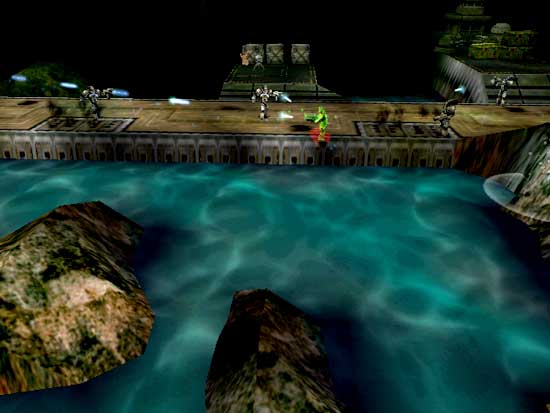Environment-Mapped Bump Mapping - The Term we never knew Existed
You all remember the game Trespasser right? It was supposed to be one of the most realistic gaming titles ever released due to its incredibly accurate (and what we all eventually realized was an incredible unplayable) physics engine. However I couldn't help but notice that the quality of the graphics in the game were completely horrible on my (at the time) Voodoo2 SLI setup, especially when looking at or swimming in water.
Although the NVIDIA Riva TNT did make the water look considerably better, there was still an obvious separation between what water even remotely looks like, and what was present in the game. After talking with a friend, we both came to the conclusion that the quality of effects such as water or the textures on walls are still far from realistic. We've all noticed at one point or another that the water in our favorite first person shooters don't look all too "water-like" and the wooden textures in our nerdy-past times don't really look all that different from pieces of plastic on the screen, but we've never known what we were lacking all this time.
While Matrox can't claim exclusive rights to the technology behind VCQ2, they can claim that they are the only desktop accelerator in this scope that supports a technology known as Environment-Mapped Bump Mapping. Bump Mapping is a technology that allows a texture to appear more realistic by the inclusion of individual bumps in the texture. If you look closely at a painted wall in real life (not in Q3A world guys) you'll notice that the wall isn't perfectly smooth, there are bumps and numerous imperfections. Bump Mapping essentially allows for those bumps to be put on walls and basically any textures in a game. It truly makes your gaming experience something else. NVIDIA supports a type of bump mapping known as embossed bump mapping, which can be considered a form of what we're talking about, but not the best and most realistic. Embossing is basically a cheap work around to avoid Dot Product 3 or Environment-Mapped Bump Mapping, the latter being the implementation Matrox used in the G400 (3Dlabs Permedia 3 will be the only card that will support Dot Product 3 Bump Mapping, it should be at least equal in quality to what the G400 can product with Environment-Mapped Bump Mapping).
Instead of manipulating a standalone texture map to make it "look" like it has bumps on it, Environment-Mapped Bump Mapping adds a third texture to the rendering sequence (in cases where both an Environment Map and a Texture Map are present). The third texture, or the bump-map, is nothing more than the basic environment map with bumps and grooves. Since the G400 is capable of single pass multi-texturing (as well as 2 pixels per clock in the event that only a single texture is being processed), the Environment Map and Texture Map are processed first in 1 clock cycle, then the Bump-Map is added on top of them in 1/2 a clock cycle. It's simple addition of textures, unfortunately the added 1/2 clock cycle required by the Bump-Map does tend to slow things down a little.
Using Rage Software's Expendable, an incredible looking game, there was a noticeable drop in frame rate when Bump Mapping was enabled near points of extensive use of Environment-Mapped Bump Mapping. At 1024 x 768 x 32-bit color & 32-bit Z-buffer on a normal Pentium II 400, the frame rate dropped from extremely fluid to a point where the game was a little choppy. The game was still playable, although be warned that there is a drop in performance. If you look at it from the point of view of the G400 chip itself, it makes sense that there would be a drop in performance as you're making the processor calculate information for another 1/2 clock cycle just so you can look at pretty water - the things we make our computers do ;)
No Bump Mapping

Environment Mapped Bump Mapping

Will Bump Mapping catch on? Considering that the only requirement for a game to support Environment Mapped Bump Mapping is that the developer makes use of DirectX 6 or greater and includes specific support for it (not too complex), don't be too surprised if the market leaves some doors open for G400 users. Hopefully other manufacturers will catch on and we'll see Environment Mapped Bump Mapping catch on big time, it would be sad to lose this kind of quality because of poor market support.










0 Comments
View All Comments